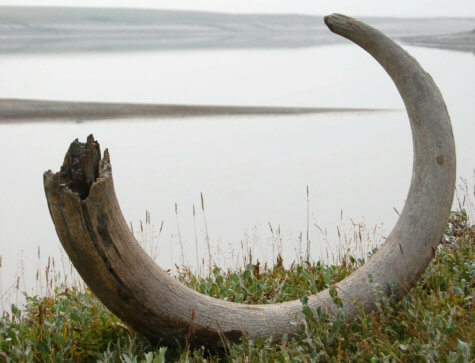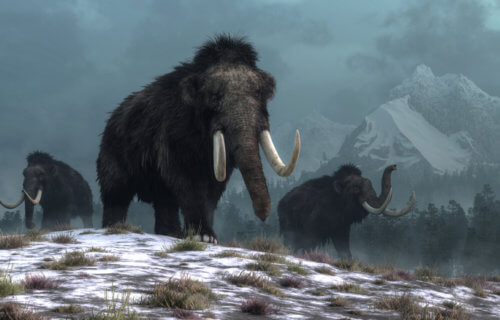CAMBRIDGE, England — The woolly mammoth’s demise has been debated for centuries, with prehistoric hunters as the main suspects. However, according to new research, the giant herbivore met its end due to climate change, not humans.
Scientists say that global warming happened so fast at the time that vegetation disappeared, and woolly mammoths starved to death. An analysis of plant and animal remains including urine, feces, and skin cells now provides the definitive answer.
“Scientists have argued for hundreds of years about why mammoths went extinct. Humans have been blamed because the animals had survived for millions of years without climate change killing them off before. But when they lived alongside humans they didn’t last long and we were accused of hunting them to death,” says study co-author Eske Willerslev of Cambridge University in England and the study’s corresponding author, in a statement.
Unearthing history from the Arctic
Ancient soil samples were painstakingly collected over 20 years from sites in the Arctic where mammoth bones have been found. “We have finally been able to prove that it was not just the climate changing that was the problem, but the speed of it that was the final nail in the coffin. They were not able to adapt quickly enough when the landscape dramatically transformed and their food became scarce,” explains Willerslev.

Melted icebergs flooded the steppe tundra wiping out the plants, flowers, and small shrubs that sustained the mammoths. The animals used their enormous tusks, which grew up to 14 feet long, to shovel snow aside and uproot tough grasses. “As the climate warmed up, trees and wetland plants took over and replaced the mammoth’s grassland habitats,” says Willerslev.
The hairy cousins of today’s elephants lived alongside early humans and were a regular staple of their diet. Their skeletons and huge tusks were used to build shelters and harpoons. Artwork featuring them is daubed on cave walls. A 30,000-year-old flute made out of a mammoth bone is the oldest known musical instrument. But there is little direct evidence of our ancestors actually killing mammoths.
“And we should remember there were a lot of animals around that were easier to hunt than a giant woolly mammoth — they could grow to the height of a double-decker bus,” Willerslev adds.
Woolly mammoths among the world’s most fascinating creatures
Woolly mammoths and their ancestors are among the most successful creatures that ever roamed Earth. They were around for five million years until finally vanishing for good nearly 4,000 years ago. Prof. Willerslev and colleagues say the ten-year study finally proves why. It was based on “DNA shotgun sequencing” that breaks a genome into small fragments to identify organisms. The laboratory technique has been used during the pandemic to track COVID by testing sewage. It enables experts to recreate ancient genetic profiles without relying on bones or teeth.
Mammoths evolved and weathered several Ice Ages. Vast herds thrived, alongside reindeer and woolly rhinoceroses. Despite the cold and snowy conditions, there was plenty of vegetation to keep them alive. Mammoths could travel a distance equivalent to going around the world twice during their lifetime. Fossil records show they lived on all continents except Australia and South America.
Populations were known to have initially survived the end of the last Ice Age in small pockets off the coasts of Siberia and Alaska — on Wrangel Island and St. Paul Island. But the research found they actually lived longer elsewhere. Both island breeds were closely related, despite being geographically separated. The DNA of 1,500 Arctic plants was mapped as part of the project to be able to draw globally significant conclusions.
“The most recent Ice Age — called the Pleistocene — ended 12,000 years ago when the glaciers began to melt and the roaming range of the herds of mammoths decreased. It was thought mammoths began to go extinct then, but we also found they actually survived beyond the Ice Age all in different regions of the Arctic and into the Holocene — the time that we are currently living in — far longer than scientists realized,” notes study first author Dr. Yucheng Wang, also from Cambridge.

“We zoomed into the intricate detail of the environmental DNA and mapped out the population spread of these mammals and showed how it becomes smaller and smaller and their genetic diversity gets smaller and smaller too, which made it even harder for them to survive. When the climate got wetter and the ice began to melt it led to the formation of lakes, rivers, and marshes,” Dr. Wang continues. “The ecosystem changed and the biomass of the vegetation reduced and would not have been able to sustain the herds of mammoths. We have shown that climate change, specifically precipitation, directly drives the change in the vegetation — humans had no impact on them at all based on our models.”
Mammoths were even around when the pyramids were being built. Their disappearance is the last big naturally occurring extinction story. Our fascination continues today with Manny, the woolly mammoth, star of five Ice Age animated films. Woolly mammoths could even be “resurrected” within six years. Harvard geneticists have raised $15m to try to bring them back.
‘Nothing is guaranteed when it comes to dramatic changes in weather’
Prof. Willerslev says the discovery has implications for the climate crisis the world faces today: “This is a stark lesson from history and shows how unpredictable climate change is — once something is lost, there is no going back. Precipitation was the cause of the extinction of woolly mammoths through the changes to plants. The change happened so quickly that they could not adapt and evolve to survive.
“It shows nothing is guaranteed when it comes to the impact of dramatic changes in the weather,” he continues. “The early humans would have seen the world change beyond all recognition — that could easily happen again and we cannot take for granted that we will even be around to witness it. The only thing we can predict with any certainty is that the change will be massive.”
The mammoth was identified as an extinct species of elephant by Georges Cuvier in 1796. It was roughly the same size as modern African elephants. Males reached more than 11 feet tall and weighed up to six tons.
This study is published in the journal Nature.
South West News Service writer Mark Waghorn contributed to this report.
